Hossein Rahmani
LLM-based Agentic Reasoning Frameworks: A Survey from Methods to Scenarios
Aug 25, 2025Abstract:Recent advances in the intrinsic reasoning capabilities of large language models (LLMs) have given rise to LLM-based agent systems that exhibit near-human performance on a variety of automated tasks. However, although these systems share similarities in terms of their use of LLMs, different reasoning frameworks of the agent system steer and organize the reasoning process in different ways. In this survey, we propose a systematic taxonomy that decomposes agentic reasoning frameworks and analyze how these frameworks dominate framework-level reasoning by comparing their applications across different scenarios. Specifically, we propose an unified formal language to further classify agentic reasoning systems into single-agent methods, tool-based methods, and multi-agent methods. After that, we provide a comprehensive review of their key application scenarios in scientific discovery, healthcare, software engineering, social simulation, and economics. We also analyze the characteristic features of each framework and summarize different evaluation strategies. Our survey aims to provide the research community with a panoramic view to facilitate understanding of the strengths, suitable scenarios, and evaluation practices of different agentic reasoning frameworks.
TSTMotion: Training-free Scene-aware Text-to-motion Generation
May 05, 2025Abstract:Text-to-motion generation has recently garnered significant research interest, primarily focusing on generating human motion sequences in blank backgrounds. However, human motions commonly occur within diverse 3D scenes, which has prompted exploration into scene-aware text-to-motion generation methods. Yet, existing scene-aware methods often rely on large-scale ground-truth motion sequences in diverse 3D scenes, which poses practical challenges due to the expensive cost. To mitigate this challenge, we are the first to propose a \textbf{T}raining-free \textbf{S}cene-aware \textbf{T}ext-to-\textbf{Motion} framework, dubbed as \textbf{TSTMotion}, that efficiently empowers pre-trained blank-background motion generators with the scene-aware capability. Specifically, conditioned on the given 3D scene and text description, we adopt foundation models together to reason, predict and validate a scene-aware motion guidance. Then, the motion guidance is incorporated into the blank-background motion generators with two modifications, resulting in scene-aware text-driven motion sequences. Extensive experiments demonstrate the efficacy and generalizability of our proposed framework. We release our code in \href{https://tstmotion.github.io/}{Project Page}.
MonoDiff9D: Monocular Category-Level 9D Object Pose Estimation via Diffusion Model
Apr 14, 2025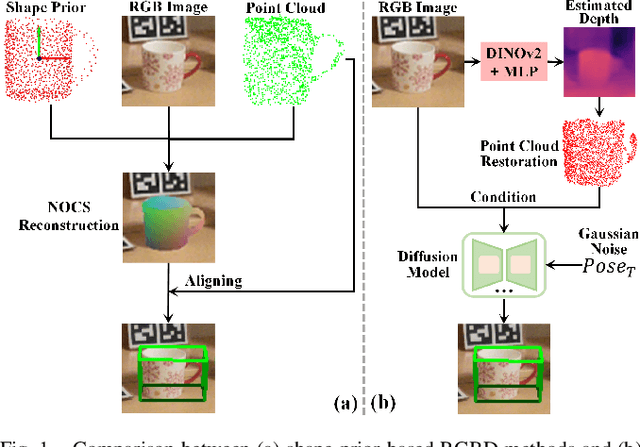
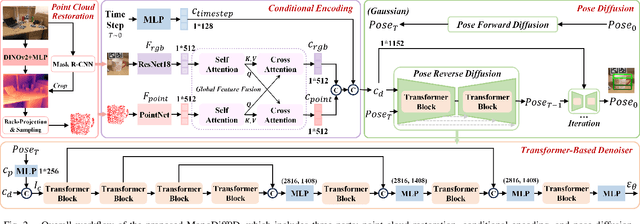


Abstract:Object pose estimation is a core means for robots to understand and interact with their environment. For this task, monocular category-level methods are attractive as they require only a single RGB camera. However, current methods rely on shape priors or CAD models of the intra-class known objects. We propose a diffusion-based monocular category-level 9D object pose generation method, MonoDiff9D. Our motivation is to leverage the probabilistic nature of diffusion models to alleviate the need for shape priors, CAD models, or depth sensors for intra-class unknown object pose estimation. We first estimate coarse depth via DINOv2 from the monocular image in a zero-shot manner and convert it into a point cloud. We then fuse the global features of the point cloud with the input image and use the fused features along with the encoded time step to condition MonoDiff9D. Finally, we design a transformer-based denoiser to recover the object pose from Gaussian noise. Extensive experiments on two popular benchmark datasets show that MonoDiff9D achieves state-of-the-art monocular category-level 9D object pose estimation accuracy without the need for shape priors or CAD models at any stage. Our code will be made public at https://github.com/CNJianLiu/MonoDiff9D.
Novel Object 6D Pose Estimation with a Single Reference View
Mar 07, 2025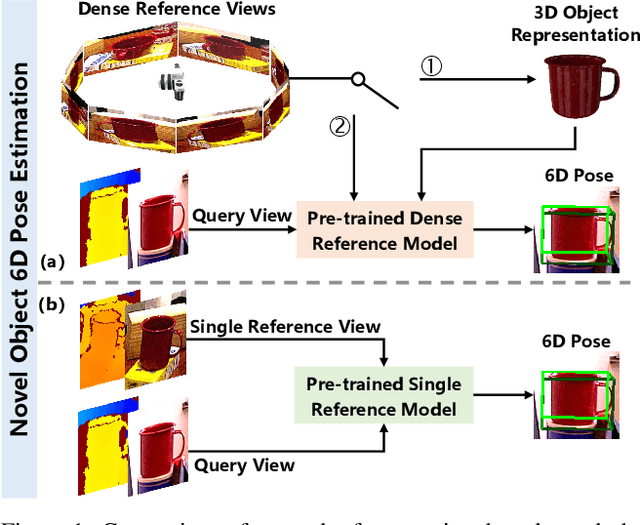

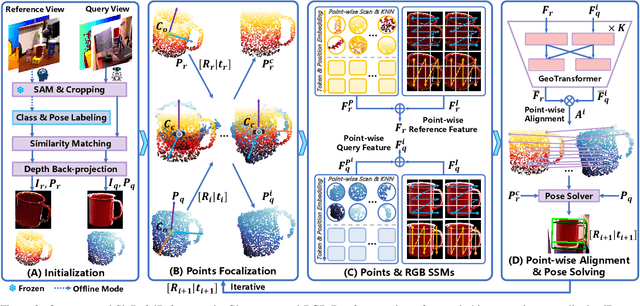
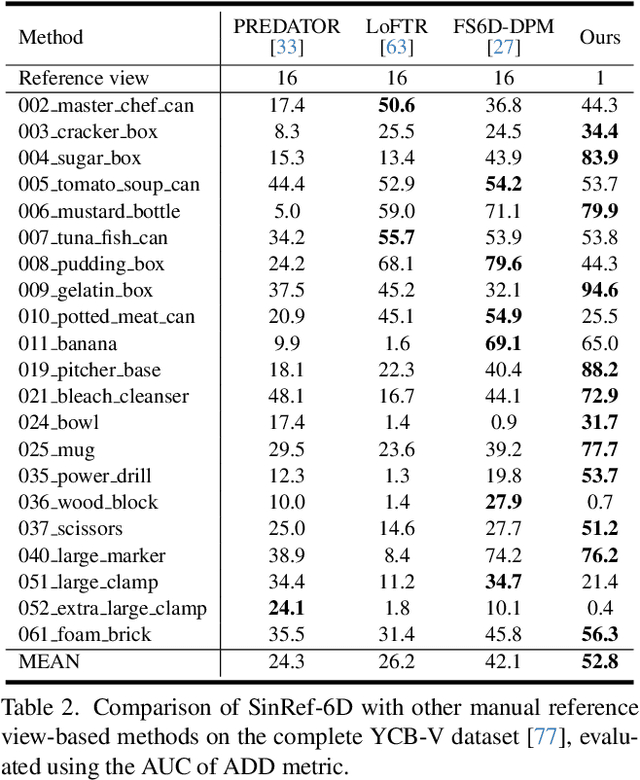
Abstract:Existing novel object 6D pose estimation methods typically rely on CAD models or dense reference views, which are both difficult to acquire. Using only a single reference view is more scalable, but challenging due to large pose discrepancies and limited geometric and spatial information. To address these issues, we propose a Single-Reference-based novel object 6D (SinRef-6D) pose estimation method. Our key idea is to iteratively establish point-wise alignment in the camera coordinate system based on state space models (SSMs). Specifically, iterative camera-space point-wise alignment can effectively handle large pose discrepancies, while our proposed RGB and Points SSMs can capture long-range dependencies and spatial information from a single view, offering linear complexity and superior spatial modeling capability. Once pre-trained on synthetic data, SinRef-6D can estimate the 6D pose of a novel object using only a single reference view, without requiring retraining or a CAD model. Extensive experiments on six popular datasets and real-world robotic scenes demonstrate that we achieve on-par performance with CAD-based and dense reference view-based methods, despite operating in the more challenging single reference setting. Code will be released at https://github.com/CNJianLiu/SinRef-6D.
Diff9D: Diffusion-Based Domain-Generalized Category-Level 9-DoF Object Pose Estimation
Feb 04, 2025Abstract:Nine-degrees-of-freedom (9-DoF) object pose and size estimation is crucial for enabling augmented reality and robotic manipulation. Category-level methods have received extensive research attention due to their potential for generalization to intra-class unknown objects. However, these methods require manual collection and labeling of large-scale real-world training data. To address this problem, we introduce a diffusion-based paradigm for domain-generalized category-level 9-DoF object pose estimation. Our motivation is to leverage the latent generalization ability of the diffusion model to address the domain generalization challenge in object pose estimation. This entails training the model exclusively on rendered synthetic data to achieve generalization to real-world scenes. We propose an effective diffusion model to redefine 9-DoF object pose estimation from a generative perspective. Our model does not require any 3D shape priors during training or inference. By employing the Denoising Diffusion Implicit Model, we demonstrate that the reverse diffusion process can be executed in as few as 3 steps, achieving near real-time performance. Finally, we design a robotic grasping system comprising both hardware and software components. Through comprehensive experiments on two benchmark datasets and the real-world robotic system, we show that our method achieves state-of-the-art domain generalization performance. Our code will be made public at https://github.com/CNJianLiu/Diff9D.
Identifying Drift, Diffusion, and Causal Structure from Temporal Snapshots
Oct 30, 2024Abstract:Stochastic differential equations (SDEs) are a fundamental tool for modelling dynamic processes, including gene regulatory networks (GRNs), contaminant transport, financial markets, and image generation. However, learning the underlying SDE from observational data is a challenging task, especially when individual trajectories are not observable. Motivated by burgeoning research in single-cell datasets, we present the first comprehensive approach for jointly estimating the drift and diffusion of an SDE from its temporal marginals. Assuming linear drift and additive diffusion, we prove that these parameters are identifiable from marginals if and only if the initial distribution is not invariant to a class of generalized rotations, a condition that is satisfied by most distributions. We further prove that the causal graph of any SDE with additive diffusion can be recovered from the SDE parameters. To complement this theory, we adapt entropy-regularized optimal transport to handle anisotropic diffusion, and introduce APPEX (Alternating Projection Parameter Estimation from $X_0$), an iterative algorithm designed to estimate the drift, diffusion, and causal graph of an additive noise SDE, solely from temporal marginals. We show that each of these steps are asymptotically optimal with respect to the Kullback-Leibler divergence, and demonstrate APPEX's effectiveness on simulated data from linear additive noise SDEs.
GaussianBlock: Building Part-Aware Compositional and Editable 3D Scene by Primitives and Gaussians
Oct 02, 2024


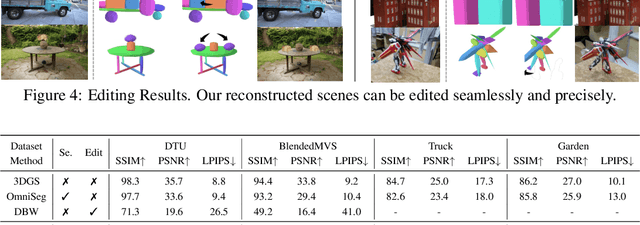
Abstract:Recently, with the development of Neural Radiance Fields and Gaussian Splatting, 3D reconstruction techniques have achieved remarkably high fidelity. However, the latent representations learnt by these methods are highly entangled and lack interpretability. In this paper, we propose a novel part-aware compositional reconstruction method, called GaussianBlock, that enables semantically coherent and disentangled representations, allowing for precise and physical editing akin to building blocks, while simultaneously maintaining high fidelity. Our GaussianBlock introduces a hybrid representation that leverages the advantages of both primitives, known for their flexible actionability and editability, and 3D Gaussians, which excel in reconstruction quality. Specifically, we achieve semantically coherent primitives through a novel attention-guided centering loss derived from 2D semantic priors, complemented by a dynamic splitting and fusion strategy. Furthermore, we utilize 3D Gaussians that hybridize with primitives to refine structural details and enhance fidelity. Additionally, a binding inheritance strategy is employed to strengthen and maintain the connection between the two. Our reconstructed scenes are evidenced to be disentangled, compositional, and compact across diverse benchmarks, enabling seamless, direct and precise editing while maintaining high quality.
Avatar Concept Slider: Manipulate Concepts In Your Human Avatar With Fine-grained Control
Aug 26, 2024Abstract:Language based editing of 3D human avatars to precisely match user requirements is challenging due to the inherent ambiguity and limited expressiveness of natural language. To overcome this, we propose the Avatar Concept Slider (ACS), a 3D avatar editing method that allows precise manipulation of semantic concepts in human avatars towards a specified intermediate point between two extremes of concepts, akin to moving a knob along a slider track. To achieve this, our ACS has three designs. 1) A Concept Sliding Loss based on Linear Discriminant Analysis to pinpoint the concept-specific axis for precise editing. 2) An Attribute Preserving Loss based on Principal Component Analysis for improved preservation of avatar identity during editing. 3) A 3D Gaussian Splatting primitive selection mechanism based on concept-sensitivity, which updates only the primitives that are the most sensitive to our target concept, to improve efficiency. Results demonstrate that our ACS enables fine-grained 3D avatar editing with efficient feedback, without harming the avatar quality or compromising the avatar's identifying attributes.
Diff-Tracker: Text-to-Image Diffusion Models are Unsupervised Trackers
Jul 11, 2024Abstract:We introduce Diff-Tracker, a novel approach for the challenging unsupervised visual tracking task leveraging the pre-trained text-to-image diffusion model. Our main idea is to leverage the rich knowledge encapsulated within the pre-trained diffusion model, such as the understanding of image semantics and structural information, to address unsupervised visual tracking. To this end, we design an initial prompt learner to enable the diffusion model to recognize the tracking target by learning a prompt representing the target. Furthermore, to facilitate dynamic adaptation of the prompt to the target's movements, we propose an online prompt updater. Extensive experiments on five benchmark datasets demonstrate the effectiveness of our proposed method, which also achieves state-of-the-art performance.
Towards Adaptive Pseudo-label Learning for Semi-Supervised Temporal Action Localization
Jul 10, 2024Abstract:Alleviating noisy pseudo labels remains a key challenge in Semi-Supervised Temporal Action Localization (SS-TAL). Existing methods often filter pseudo labels based on strict conditions, but they typically assess classification and localization quality separately, leading to suboptimal pseudo-label ranking and selection. In particular, there might be inaccurate pseudo labels within selected positives, alongside reliable counterparts erroneously assigned to negatives. To tackle these problems, we propose a novel Adaptive Pseudo-label Learning (APL) framework to facilitate better pseudo-label selection. Specifically, to improve the ranking quality, Adaptive Label Quality Assessment (ALQA) is proposed to jointly learn classification confidence and localization reliability, followed by dynamically selecting pseudo labels based on the joint score. Additionally, we propose an Instance-level Consistency Discriminator (ICD) for eliminating ambiguous positives and mining potential positives simultaneously based on inter-instance intrinsic consistency, thereby leading to a more precise selection. We further introduce a general unsupervised Action-aware Contrastive Pre-training (ACP) to enhance the discrimination both within actions and between actions and backgrounds, which benefits SS-TAL. Extensive experiments on THUMOS14 and ActivityNet v1.3 demonstrate that our method achieves state-of-the-art performance under various semi-supervised settings.
 Add to Chrome
Add to Chrome Add to Firefox
Add to Firefox Add to Edge
Add to Edge